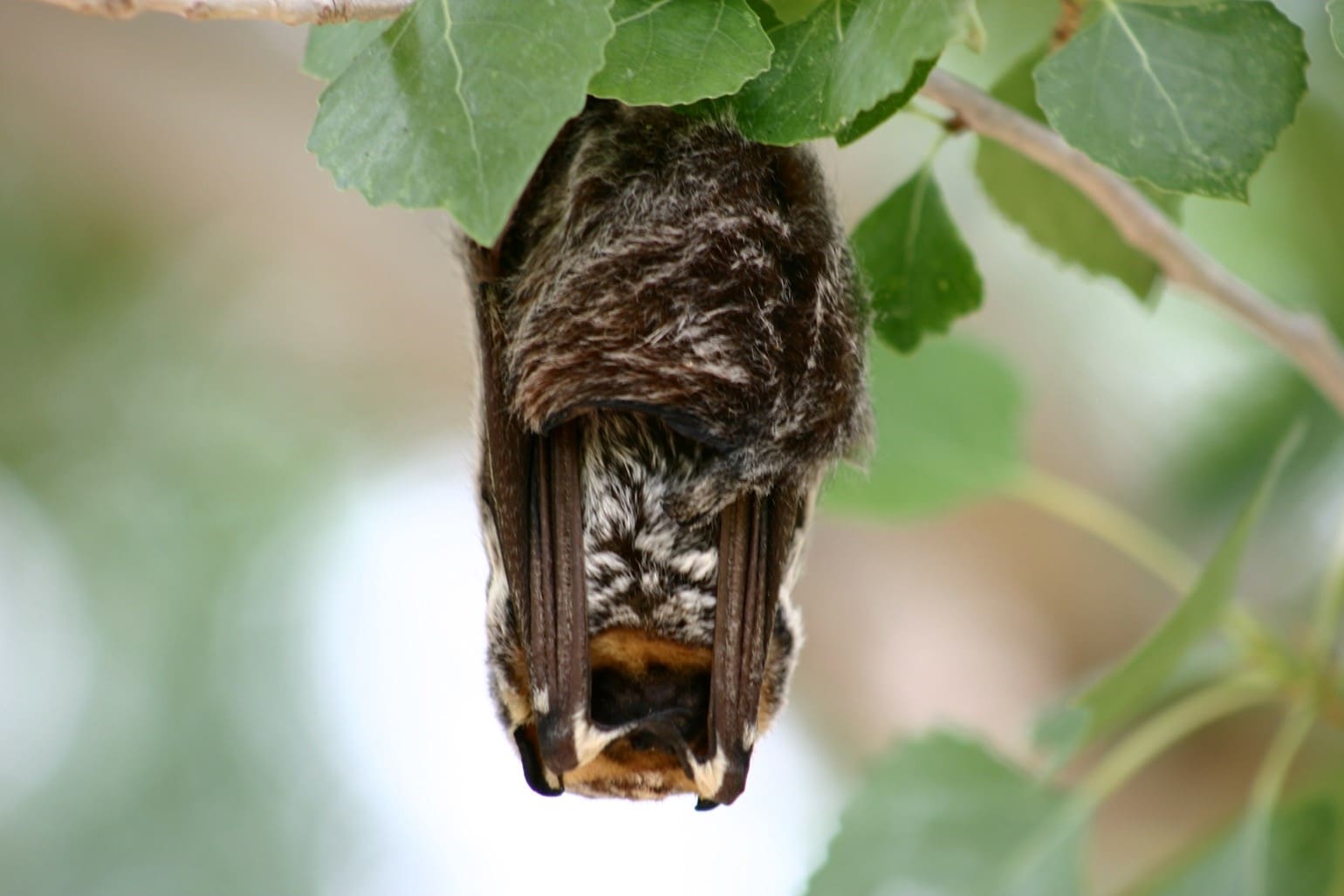The Hoary Bat

WHAT SAYS “HALLOWEEN” BETTER THAN A BAT?
“What’s that hanging over there in the cottonwood tree?” I can’t remember who saw the sleeping hoary bat (Lasiurus cinereus) first, but there he was, hanging almost at eye level in the Clark County Wetlands Park Nature Preserve’s Cottonwood Gallery. Our Park volunteers were setting up an activity table in the cool, green shade when we spotted him. Volunteer photographer Dana Bubp got to “clicking” photos right away—we were so excited. As bats are typically nocturnal creatures and the Park is typically closed after dusk, we don’t get to see them “up close and personal” very often!
“Bats!” Donald R. Griffin says in National Geographic’s classic book Wild Animals of North America. “The very word sends womenfolk scurrying for cover, hands clutching their hair. Centuries of superstition, hair-raising stories of vampires, and a few glimpses of elusive shapes darting through the evening sky – these make up the average person’s impression of bats. Yet those we see in the United States are beneficial, interesting, and mostly harmless little mouse-sized creatures, the only vertebrates other than birds that can truly fly.”
Bats are far too agile and good at navigation to get tangled in anyone’s hair, and none of the species native to the United States drink blood or change into vampires at sunset. Instead, they are wonderful insect control agents, eating a third to a half of their body weight every day. Bats do have sharp little teeth and they will use them if picked up or threatened. A bat bite in itself is not serious, but like many mammals, bats can carry rabies, so nips are best avoided.
Hoary bats are found across the continental United States, north into southern Canada, and south into Mexico and Central America – the second largest range of any North American mammal. Even in Hawaii there is an endangered hoary bat subspecies not found elsewhere. Those in northern areas migrate south each year to avoid winter weather. I have often wondered if our sleeping hoary bat in the Park was a tired migrant resting on his spring journey to his northern home. His not being a “local” would explain why he hung up to rest in such an exposed place, so low to the ground, and so easy to see.
Hoarys are large as bats go, almost six inches long from head to tail, with a wingspan of 13 to 16 inches. Each hair in the bat’s soft coat is multicolored blackish brown and tan with a white tip, giving the impression that it stayed out too late in the cold and got dusted with hoar frost (the frost occurring on a clear, cold night when water vapor transitions immediately from a gaseous to solid state; hence the common name). The short, rounded ears have black edges, and the neck is circled by a distinctive yellow collar. Unlike some bats, the membrane that encloses the tails is fully furred.
Hoary bats are solitary “later-in-the-night” hunters, feasting mostly on moths with a few dragonflies, true bugs, mosquitoes and other insects for variety. They are sometimes seen in flight hunting around streetlights and making a “chattering” sound that is audible to human ears. By day they roost well separated from each other and (usually) almost unseen in trees. Their coloration makes them hard to see against tree bark. Their trick of wrapping themselves in their furry tail membrane and hanging up by only one foot makes them look like dried leaves, and even harder to spot!
As Griffin noted, “This is no leather-winged dragon, but a harmless, intriguing little beast with a long evolutionary history of instrument flying.” So, at Halloween (or any time of year): if you get to see a hoary bat either roosting or in flight, you have just had a wonderful gift from nature.
– By Chris Leavitt, President; photo by Dana Bubp
Please enjoy these YouTube videos!
Hoary bat (Lasiurus cinereus)
Lasirus cinereus
Veterinarian Discusses Hoary Bat Facts at the Austin Bat Refuge
